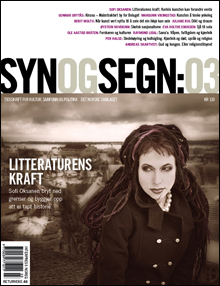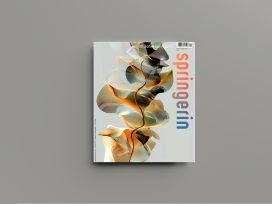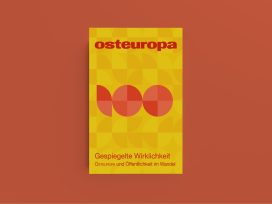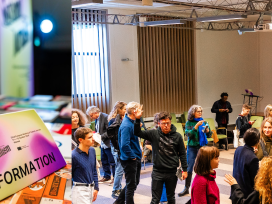Gender representation in the organizations essential to journal publication
Syn og Segn‘s gender policy is to accomplish full gender equality, both with regard to our staff and our contributors. Currently we have two female employees, but no male employees. As the editor, I work part-time, sharing a full-time position with the editorial assistant 40/60. There is no discrepancy in pay as concerns female and male workers.
During my term as editor, it’s been a clear aim to achieve full gender equality, when it comes to both staff and the division of labour. I’ve had both male and female employees as editorial assistants in my time as editor. Prior to my time as editor, at least in the last 15 years, both genders have been represented as both editors and editorial assistants, working side-by-side.

It’s difficult to say what the future will bring. The next editor of Syn og Segn is male, and will soon be working full-time as our only employee. But we believe that, should he hire an assistant, he would seek gender equality.
I do take an authors’s gender into consideration when selecting articles for publication. Searching for female contributors does not require extra work. I simply try to have as many female contributors as male contributors, though this goal is not fully met in every issue.
In 2012, we had 21 female contributors, and 26 male contributors. No major changes occurred in the female/male ratio among authors during my term as editor. During the last 13 years, Syn og Segn has had female editors. This has, in our case, contributed to a rise in female contributors. I expect that our next editor will follow up on achieving a balance between male and female contributors.
Gender and cultural journals
Eurozine partner journals are not unique in being dominated by male editors and contributors. But what’s the bigger picture regarding gender and cultural journals? Do journals have the resources to deal with it? And what role does gender play, if any, where commissioning patterns and content are concerned?
Eurozine asked selected partner journals to respond to a European survey on gender and cultural journals that examines these issues in greater depth.
Dialogi, Slovenia
Soundings, UK
Syn og Segn, Norway
Esprit, France
Merkur, Germany
Gernero, Serbia
ResPublica Nova, Poland
Spilne, Ukraine
L’Homme, Austria
Of the journal’s owners, three are male, and five female. As for the editorial/advisory board, this consists of four males and four females. Gender will always be a topic of discussion, a natural part of conversations regarding employment, but we have no quota or any other formal ways of meeting the goal of gender equality.
Gender and content
There is a tendency for women to write more on gender issues than men in Norway. The same applies to Syn og Segn. But there are exceptions, for instance in articles about homosexuality, where a majority of authors are men.
Kristin Fridtun, a young writer and transperson, wrote in Syn og Segn 1/2012 about homosexuality in Viking times with reference to quotations and attitudes concerning especially males in old Norse sagas and runes found in Norway and Iceland.
In the same issue, Solveig Aareskjold, a Norwegian writer of fiction and non-fiction, wrote about the tradition of Odel, according to which the oldest son inherits the farm, and how the law has changed in modern times.
In Syn og Segn 2/2012, professor Stephen J. Walton wrote about gender in Mexico, about muxe and what can be called “the third gender” among transvestites in Juchitan, Mexico.
In Syn og Segn 3/2012, Toril Moi, distinguished professor of literature, was interviewed on gender issues among modern Norwegian women, such as domestic cosiness, baking cupcakes and making things oneself, which is a big trend. Moi found this development off-putting, saying that the trend threatens equality and feminism.
We very seldom have articles written by more than one author, and there has not been a problem getting people to write about gender issues. Gender is high on the agenda in Norway, and a lot of writers are occupied with gender issues.
We have not given so much thought to the role that gender plays in connection with other fields. We simply try to include articles by both men, women and transpersons. And we search for good writers, no matter the gender they might have.
We expect all genders to become more and more equal in terms of education and knowledge in different fields in the future. However, today there are more women at the universities in Norway, but still more men with university positions, both in terms of professors and other academic positions as well as management jobs. We hope that the female majority in universities will have an impact on the gender balance in leading positions and in publishing, as well as on the writing of articles in journals and academic literature and on the media in general.
Gender and audience
Syn og Segn conducted research with QuestBack in 2010, which showed that a majority of our subscribers are male, well-educated and enjoy an above average salary. They are also very happy with the content and are long-term subscribers. However, this was a one-off survey and gender was not an explicit topic.
We have received no public critique of our coverage of gender issues.
Gender quota
With regard to staff, quotas for women are not necessary. In my case, when I was applying for the job as editor, two women hired me. When it comes to the journal’s content however, a quota for women should be a goal, a thought that is always with us – but not a rule.







